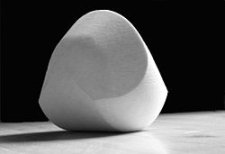
« PREVIOUS ENTRY
Knot physics: My Times Year in Ideas piece
NEXT ENTRY »
Why you shouldn’t exercise to indie rock

A couple of weeks ago, the New York Times Magazine published its 2007 “Year in Ideas” issue — their annual compendium of the year’s most interesting and offbeat research. I wrote up five of their scientific and technological entries. The entire issue is online here for free, but I’m also archiving my pieces here for posterity’s sake.
This is one really fun — it’s about the “Gomboc”, the world’s first self-righting object: An object with only one stable and one unstable point of balance. You can see a video of the Gomboc in action here!
The self-righting object
The Gomboc is a roundish piece of clear synthetic material with gently peaked, organic curves. It looks like a piece of modern art. But if you tip it over, something unusual happens: it rights itself.
It leans off to one side, rocks to and fro as if gathering strength and then, presto, tips itself back into a “standing” position as if by magic. It doesn’t have a hidden counterweight inside that helps it perform this trick, like an inflatable punching-bag doll that uses ballast to bob upright after you whack it. No, the Gomboc is something new: the world’s first self-righting object.
The Gomboc is a result of a long mathematical quest. In 1995, the Russian mathematician Vladimir Arnold mused that it would be possible to create a “mono-monostatic” object — a three-dimensional thingy that purely by dint of its geometry had only one possible way to balance upright.
The challenge intrigued two scientists — Gabor Domokos and Peter Varkonyi, both of the Budapest University of Technology and Economics. They spent a few years doing the math, and it seemed as if a mono-monostatic object could, in fact, exist. They began looking to see if they could find a naturally occurring example; at one point, Domokos was so obsessed that he spent hours testing 2,000 pebbles on a beach to see if they could right themselves. (None could.)
After several more years of scratching their heads, they finally hit upon a shape that looked promising. They designed it on a computer, and when it came back from the manufacturer, they nervously tipped it over, wondering if all their work would be for naught. Nope: the Gomboc performed perfectly. “It’s a very nice mathematical problem because you can hold the proof in your hands — and it’s quite beautiful,” Varkonyi says.
Yet the scientists now say that Mother Nature may have beaten them in the race after all. They have noticed that the Gomboc closely resembles the shell of a tortoise or a beetle, creatures whose round-shelled backs help them right themselves when flipped over. “We discovered it with mathematics,” Domokos notes, “but evolution got there first.”
I'm Clive Thompson, the author of Smarter Than You Think: How Technology is Changing Our Minds for the Better (Penguin Press). You can order the book now at Amazon, Barnes and Noble, Powells, Indiebound, or through your local bookstore! I'm also a contributing writer for the New York Times Magazine and a columnist for Wired magazine. Email is here or ping me via the antiquated form of AOL IM (pomeranian99).

ECHO
Erik Weissengruber
Vespaboy
Terri Senft
Tom Igoe
El Rey Del Art
Morgan Noel
Maura Johnston
Cori Eckert
Heather Gold
Andrew Hearst
Chris Allbritton
Bret Dawson
Michele Tepper
Sharyn November
Gail Jaitin
Barnaby Marshall
Frankly, I'd Rather Not
The Shifted Librarian
Ryan Bigge
Nick Denton
Howard Sherman's Nuggets
Serial Deviant
Ellen McDermott
Jeff Liu
Marc Kelsey
Chris Shieh
Iron Monkey
Diversions
Rob Toole
Donut Rock City
Ross Judson
Idle Words
J-Walk Blog
The Antic Muse
Tribblescape
Little Things
Jeff Heer
Abstract Dynamics
Snark Market
Plastic Bag
Sensory Impact
Incoming Signals
MemeFirst
MemoryCard
Majikthise
Ludonauts
Boing Boing
Slashdot
Atrios
Smart Mobs
Plastic
Ludology.org
The Feature
Gizmodo
game girl
Mindjack
Techdirt Wireless News
Corante Gaming blog
Corante Social Software blog
ECHO
SciTech Daily
Arts and Letters Daily
Textually.org
BlogPulse
Robots.net
Alan Reiter's Wireless Data Weblog
Brad DeLong
Viral Marketing Blog
Gameblogs
Slashdot Games